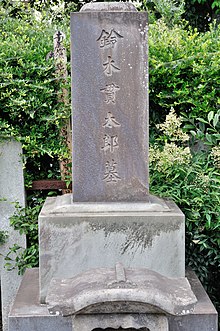Kantarō Suzuki
Kantarō Suzuki | |
|---|---|
鈴木 貫太郎 | |
 Suzuki c. 1940s | |
| Prime Minister of Japan | |
| In office 7 April 1945 – 17 August 1945 | |
| Monarch | Hirohito |
| Preceded by | Kuniaki Koiso |
| Succeeded by | Naruhiko Higashikuni |
| President of the Privy Council | |
| In office 15 December 1945 – 13 June 1946 | |
| Monarch | Hirohito |
| Vice President | Shimizu Tōru |
| Preceded by | Hiranuma Kiichirō |
| Succeeded by | Shimizu Tōru |
| In office 10 August 1944 – 7 April 1945 | |
| Monarch | Hirohito |
| Vice President | Shimizu Tōru |
| Preceded by | Yoshimichi Hara |
| Succeeded by | Hiranuma Kiichirō |
| Vice President of the Privy Council | |
| In office 24 June 1940 – 10 August 1944 | |
| Monarch | Hirohito |
| President | Yoshimichi Hara |
| Preceded by | Yoshimichi Hara |
| Succeeded by | Shimizu Tōru |
| Personal details | |
| Born | 18 January 1868 Kuze, IJN 3rd Fleet, Kure Naval District, Combined Fleet |
| Battles/wars | |
Baron Kantarō Suzuki (鈴木 貫太郎, 18 January 1868 – 17 April 1948[4]) was a Japanese admiral and politician. He was an admiral in the Imperial Japanese Navy, member and final leader of the Imperial Rule Assistance Association and Prime Minister of Japan from 7 April to 17 August 1945.
Biography
Early life
Suzuki was born on 18 January 1868, in
Suzuki entered the 14th class of the Imperial Japanese Naval Academy in 1884, graduating 13th of 45 cadets in 1887. Suzuki served on the corvettes Tsukuba, Tenryū and cruiser Takachiho as a midshipman. On being commissioned as ensign, he served on the corvette Amagi, cruiser Takao, corvette Jingei, ironclad Kongō, and gunboat Maya. After his promotion to lieutenant on 21 December 1892, he served as chief navigator on the corvettes Kaimon, Hiei, and Kongō.[4]
Suzuki served in the
During the
After the war, Suzuki was promoted to
Suzuki narrowly escaped assassination in the
-
Kantaro became full Admiral in 1923.
Prime Minister

On 7 April 1945, Prime Minister Kuniaki Koiso resigned and Suzuki was appointed to take his place at the age of seventy-seven. He simultaneously held the portfolios for Minister for Foreign Affairs and for Greater East Asia.
Prime Minister Suzuki contributed to the final peace negotiations with the
After the

Suzuki died of natural causes on 17 April, 1948. His grave is in his home town of Noda, Chiba. One of his two sons became director of Japan's immigration service, while the other was a successful lawyer.
Honours

From the corresponding Japanese Wikipedia article
Peerages
- Baron (20 November 1936)
Decorations
- Order of the Sacred Treasure, 2nd Class (28 August 1915; Fourth Class: 30 May 1905; Fifth Class: 30 November 1901; Sixth Class: 18 November 1895)
- Order of the Golden Kite, 3rd Class (1 April 1906; Fifth Class: 18 November 1895)
- Grand Cordon of the Order of the Rising Sun (1 April 1916; Second Class: 19 January 1916; Third Class: 1 April 1906)
- Grand Cordon of the Order of the Paulownia Flowers (April 29, 1934)
Notes
- ISBN 978-981-13-6756-4.
- ^ Mydans, Carl (1 October 1945). "Jap Admiral Hides: Vengeful terrorists are after Peacemaker Suzuki". Life.
- ^ ISBN 9780824825508.
- ^ a b c d e [1] Nishida, People of the Imperial Japanese Navy.
- ^ "≪"オール野田市"で鈴木貫太郎記念館を再建≫ 野田市鈴木貫太郎記念館 再建基金の創設へ" (PDF). Noda City. Retrieved 2022-03-05.
- ^ a b c Kowner, Historical Dictionary of the Russo-Japanese War, p. 363–365.
References
- Frank, Richard (2001). Downfall: The End of the Imperial Japanese Empire. Penguin. ISBN 0-14-100146-1.
- Gilbert, Martin (2004). The Second World War: A Complete History. Holt. ISBN 0-8050-7623-9.
- Keegan, John (2005). The Second World War. Penguin. ISBN 0-14-303573-8.
- ISBN 0-8108-4927-5.
External links
- Annotated bibliography for Suzuki Kantarō from the Alsos Digital Library for Nuclear Issues
- Nishida, Hiroshi. "Imperial Japanese Navy". Retrieved 17 August 2022.
- Suzuki Kantarō and Pacific War at 1945 (in Japanese)

